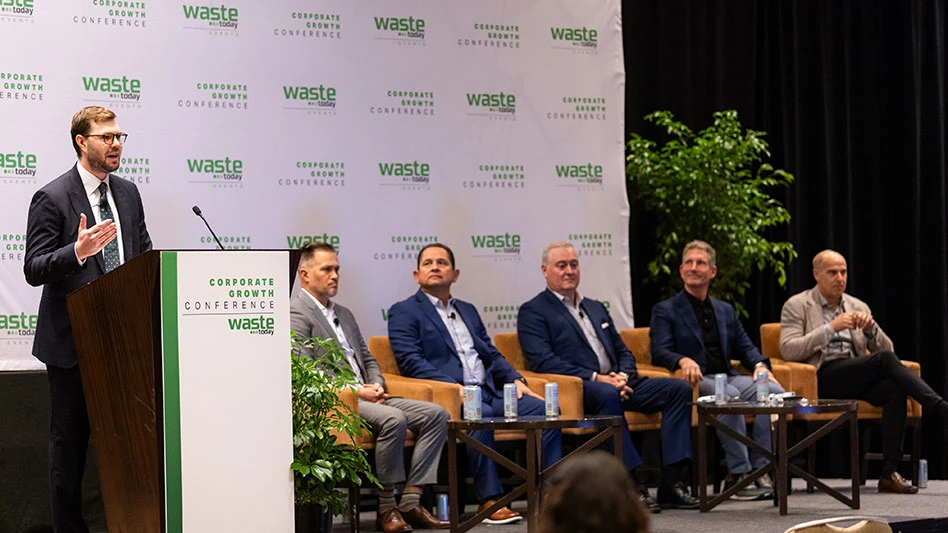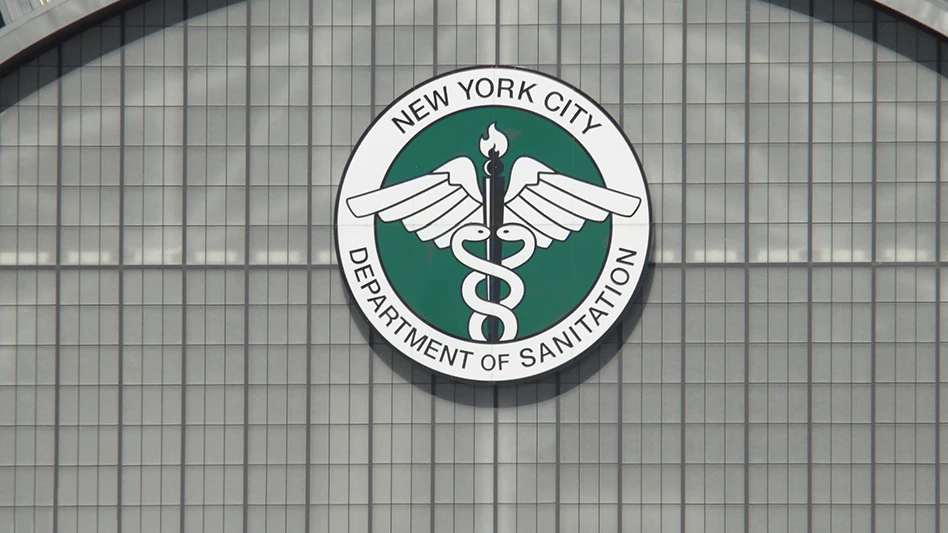
Tori Carle, the waste reduction supervisor in Greensboro, North Carolina, likens examining recycling bins for potential contamination to reading the I Spy and Where’s Waldo books she loved as a child.
“When I see a recycling cart, it’s like I’m looking at an I Spy book all morning long because I’m looking for specific things [that shouldn’t be] in there,” Carle says.
Recycling contamination occurs when materials are placed in the recycling bin that should not be there, with the biggest offenders being items such as plastic bags, food waste and expanded polystyrene foam. The higher the percentage of contamination found in the waste stream, the higher the contamination fees municipalities may pay, the slower the sorting process for recyclables and the more likely materials will head straight to the landfill at a cost to the material recovery facility.
The most effective way to reduce contamination is through education, and that’s precisely the low-tech goal of the newest high-tech artificial intelligence (AI) contamination detection solutions.
For its recycling contamination tracking program, the city of Greensboro uses mobile app technology from Prairie Robotics, a Canada-based manufacturer of AI technology for recycling trucks. Prairie Robotics’ truck technology, which encompasses on-board computers, AI cameras and high-precision GPS, is being used by slightly more than 20 cities across Canada and the U.S.
The company’s proprietary AI technology builds upon those same I Spy skills honed by people like Carle and expands them on a much larger scale to automatically identify contaminants as well as generate educational materials customized to each household with an accuracy rate of more than 99.5 percent.
The technology was designed primarily for use on side-loader trucks servicing single-family homes, says Jenny English, business development manager for Prairie Robotics, and it’s touchless, which means drivers never have to interact with it as they’re driving routes. The system captures serial numbers from collection carts and images of material dumped into the recycling truck’s hopper, using AI technology to analyze the footage for potential contaminants.
Automatically generated postcards can be sent to residents with pictures of their contamination alongside tailored messaging, which can be anything from emphasizing the financial impact of contaminated recyclables to more of a “moral” plea, such as a card that reads “Are you wishcycling?”
“The moral nudge is surprisingly the one that hits the hardest,” English says.Using data collected over time, the Prairie Robotics system can generate a heat map for municipalities that identifies contamination “hot spots,” or areas where it might make the most sense to do individual tracking, English says. It also can be integrated with systems including ReCollect and Recycle Coach to send digital notifications to residents.
Greensboro success story

Bottom: Example of a general educational postcard sent to residents.
In Greensboro, where biweekly recycling collection is provided to about 120,000 households, the city has seen significant success in reducing contamination through a combination of manual and camera audits. The efforts began in earnest after a materials audit conducted by Tampa, Florida-based Kessler Consulting found 36.2 percent contamination in the city’s collected recyclables.
“I might have cried a little bit,” Carle says. “I had very existential questions of, What have I been doing for the past six years [in this job]? Because people don’t know what to do.”
Intending to decrease contamination, Carle and her team identified the 12 most contaminated routes, which they nicknamed the Dirty Dozen, and began a precollection inspection and cart tagging program in which staff members hit the streets starting at 6 a.m., before trucks head out, to manually examine recycling bins, lifting the lid to look for contamination.
In 2023, the city began using Prairie Robotics’ mobile app, which uses cameras but not AI technology, to supplement its efforts. Staff members can use the mobile app to enter a home address, take a photo inside the bin and select visible contaminants from a drop-down menu of more than 100 options.
Carts with contamination are flagged to receive an educational postcard. Greensboro uses a “three-strike system,” in which residents will receive three educational postcards before the department considers swapping the address’ recycling cart with an extra garbage can.
“We feel like that’s fair game,” Carle says, emphasizing the goal is not to punish homeowners but to build upon the city’s efforts to reduce contamination in the waste stream. “We would rather your recycling be in the garbage than the garbage be in the recycling.”
These efforts have led to a nearly 40 percent decrease in contamination in four years of focused education and outreach, Carle says. Because of that success, the city has expanded its use of the app to yard waste and will install Prairie Robotics’ AI platform on city recycling trucks in July.
Other case studies
In East Lansing, Michigan, where Prairie Robotics rolled out a comprehensive citywide education strategy in the fall of 2022, the before-and-after data have been impressive. The city contracted with Iris Waste Diversion Specialists, Birch Run, Michigan, to conduct a series of independent MRF audits before and after the implementation of its fully automated educational campaign. Audits showed a 22.5 percent decrease in contamination.
“Prairie Robotics provides the data to focus our limited time and funds on the carts that need the help,” says Cliff Walls, environmental sustainability manager for East Lansing. “It helps the city see who needs a nudge to participate ... and provides the tools to strategically intervene exactly where it will have the most impact.”
The city of Holland, Michigan, recently became the state’s third municipality to incorporate Prairie Robotics’ technology when it launched a 12-month pilot program to improve residential recycling. With help from The Recycling Partnership and a $38,000 grant from the state Department of Environment, Great Lakes and Energy, the city is installing AI technology on city recycling trucks to check the contents of bins. City officials say they’ll use the surveillance technology to tailor “constructive feedback” at an individual household level.
Automated options
A bevvy of companies offer similar automated contamination detection solutions, including WasteVision AI, which offers a flexible AI-driven photographic platform designed to detect contamination and container overflow and that allows each truck to work from a different contamination model.
Last year, Ireland-based AMCS Group announced the deployment of its solution, AMCS Vision AI, which the company says can improve the quality of recyclables collected by automatically identifying contamination in recycling in containers without driver intervention and sharing feedback with clients. The technology also can be applied to organics and landfill streams.
Houston-based WM has its own in-house proprietary technology, Smart Truck, that uses cameras and sensors mounted on recycling trucks to scan materials and capture real-time video of the contents of customers’ bins.
The images are sent to a centralized automated system, where AI can identify recycling contamination from food waste and other nonrecyclabless. When contamination is found, WM sends emails to customers with images of their bins as well as educational information about what is and is not recyclable. During its pilot program, the company found the Smart Truck technology and educational efforts reduced recycling contamination by more than 20 percent, according to WM.
Unexpected benefits
Resident education is primarily about what not to put in bins, but it’s also an opportunity to invite residents to learn more about what is recyclable.
In East Lansing, English says, alongside the decrease in contamination rates, the city experienced an 18 percent increase in the value of recyclables per ton because of decreased contamination and increased recovery of tin cans and high-density polyethylene.
For Carle, the biggest educational success story has been the direct impact she’s seen on individual routes. For instance, one particular route on the original Dirty Dozen list went from a 55 percent contamination rate down to 41 percent on the next audit and then 16 percent on the most recent.
“I was like, holy cow, they’re not on the Dirty Dozen anymore,” Carle says. “We kept looking at that data, and we saw there was a durability of impact.”

Explore the May/June 2024 Issue
Check out more from this issue and find your next story to read.
Latest from Waste Today
- Hawaiian county selects landfill site
- CAA submits final draft program plan in Oregon
- Washington city adds organics collection to waste service
- Aspen Waste Systems expands into Denver-metro market
- NYSAR3 seeks respondents to commercial recycling survey
- Aemitis AD system goes online
- Liebherr breaks ground on logistics center
- Rubicon appoints new CFO





